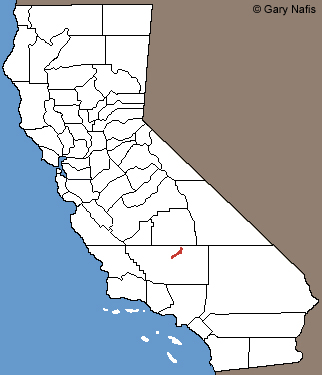 Red:
Red: Range in California
|
 |
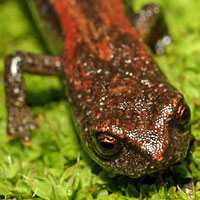 |
| Adult, Kern County |
Adult, Kern County |
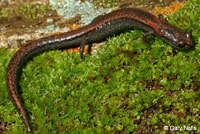 |
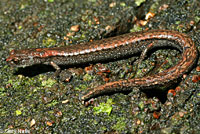 |
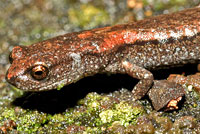 |
| Adult, Kern County |
Adult, Kern County |
Adult, Kern County |
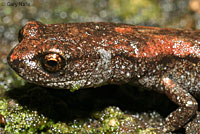 |
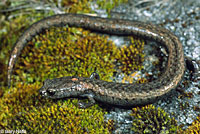 |
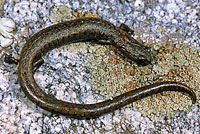 |
| Adult, Kern County |
Adult, Kern County |
Adult, Kern County, 2,400 ft. |
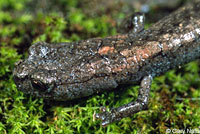 |
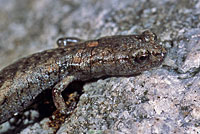 |
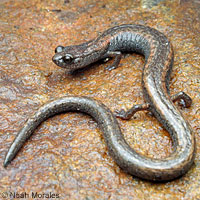 |
| Adult, Kern County |
Adult, Kern County |
Adult, Kern County © Noah Morales |
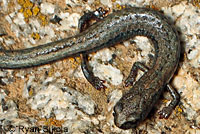 |
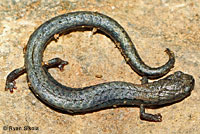 |
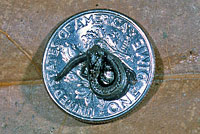 |
| Adult, Kern County © Ryan Sikola |
Adult, Kern County © Ryan Sikola |
Hatchling on U.S. dime,
Kern County, 2,400 ft. |
| |
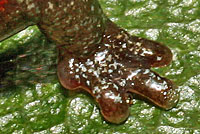 |
|
| |
Slender Salamanders (genus Batrachoseps) have only 4 toes on their hind feet. All other California salamanders have 5 toes on their hind feet. |
|
| |
|
|
| Habitat |
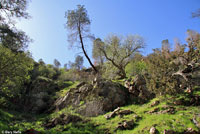 |
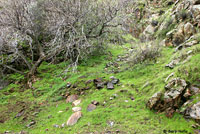 |
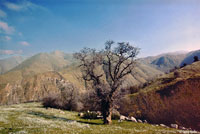 |
Habitat, 2,400 ft., Kern County
|
Habitat, 2,400 ft., Kern County |
Habitat, 1,500 ft., Kern County |
| |
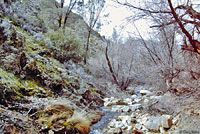 |
|
| |
Habitat, Kern County |
|
| |
|
|
| Short Video |
| |
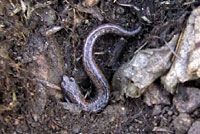 |
|
| |
An adult under a rock. |
|
|
|
|
| Description |
| |
| Size |
Adults are 1 5/8 - 2 1/5 inches long (4-5.5 cm) from snout to vent.
|
| Appearance |
A small slim salamander, with 20-21 costal grooves (with 7-9 costal folds between adpressed limbs.)
Short limbs, a narrow head, long slender body, very long tail, and conspicuous costal and caudal grooves give this species the worm-like appearance typical of most Slender Salamanders.
This species is relatively large and robust when compared with most Slender Salamanders, having a comparatively broader head, longer legs, broader feet, and larger toes.
There are four toes on the front and hind feet, which is also typical of Slender Salamanders.
(Other California salamanders have five toes on the hind feet.) |
| Color and Pattern |
The sides and ventral surfaces are dark, and flecked with a lighter color.
There may be a dorsal stripe.
|
| Life History and Behavior |
A member of family Plethodontidae, the Plethodontid or Lungless Salamanders.
Plethodontid salamanders do not breathe through lungs. They conduct respiration through their skin and the tissues lining their mouth. This requires them to live in damp environments on land and to move about on the ground only during times of high humidity. (Plethodontid salamanders native to California do not inhabit streams or bodies of water but they are capable of surviving for a short time if they fall into water.)
Plethodontid salamanders are also distinguished by their nasolabial grooves, which are vertical slits between the nostrils and upper lip that are lined with glands associated with chemoreception.
All Plethodontid Salamanders native to California lay eggs in moist places on land.
The young develop in the egg and hatch directly into a tiny terrestrial salamander with the same body form as an adult.
(They do not hatch in the water and begin their lives as tiny swimming larvae breathing through gills like some other types of salamanders.)
|
| Activity |
Little is known about this species.
Most Slender Salamander species are active on rainy or wet nights when temperatures are moderate, fall through spring, retreating underground when the soil dries or when air temperature drops to near freezing.
At higher elevations, activity may be restricted to spring and early summer and early fall. |
| Defense |
Slender salamanders use several defense tactics, including:
- Coiling and remaining still, relying on cryptic coloring to avoid detection.
- Uncoiling quickly and springing away repeatedly bouncing over the ground, then remaining still again to avoid detection.
- Detaching the tail, which wriggles on the ground to distract a predator from the salamander long enough for it to escape.
(After its tail is detached or severed, the salamander will grow a new tail.) |
| Diet and Feeding |
Probably eats a variety of small invertebrates.
Feeding behavior is not well known, but other Batrachoseps species are sit-and-wait predators that use a projectile tongue to catch prey. |
| Reproduction |
Reproduction is terrestrial.
Nothing is known of the reproduction of B. simatus within Kern Canyon.
Like other low to mid-elevation Batrachoseps, it is assumed that this species lays eggs on land between December and February, depending on stimulation by rainfall, which varies year to year. |
| Young |
Young develop completely in the egg and hatch fully formed, most likely in early spring.
A single hatchling was found on March 4th.
|
| Habitat |
Favored habitat is north-facing riparian zones in narrow canyons shaded with willows and cottonwoods and wooded hillsides supporting oaks and pines, including wet creek margins, seeps, talus, and exposed chaparral. These areas typically do not get sun in winter and remain moist and cool into the spring.
Individuals are usually found beneath rocks, logs, bark and leaf-litter during periods of high moisture, typically November to March or April, but often only February and March.
One B. simatus (found by T. Burkhardt and S.Winegarner) came from within the spray-zone of a waterfall.
Available habitat is in small disjunct patches, suggesting that population sizes are small.
Robert Hansen, 1988, determined that salamanders were found in only about 2 per cent of the available habitat (only about 17 acres.) Substantial genetic differences have been found between adjacent populations. This suggests that these populations have been isolated for a long time, and that the failure to find salamanders in areas between populations is not due to inadequate surveys.
|
| Geographical Range |
Endemic to California. Batrachoseps simatus is found in the lower Kern River Canyon from Stork Creek, 1,476 ft. (450 m) to Erskine Creek, 3,937 ft. (1200 m).
All known locality records appear to be from the south side (north face) of the canyon.
|
| Notes on Taxonomy |
In February 2012, Jockusch et al * split B. simatus into two species - B. bramei - Fairview Slender Salamander, found in the Upper Kern River Canyon, and B. simatus found only in Lower Kern River Canyon.
Jockusch et al * also assigned slender salamanders found on Cottonwood Creek outside of Kern Canyon, formerly recognized as B. simatus, to B. gregarius.
There has been no question as to the validity of this taxon since it was originally described. B. simatus is genetically and morphologically distinct from other members of the nigriventris-group.
Here's a Diagram of the Batrachoseps Complex showing the relationships between species.
Names History
Batrachoseps simatus - Kern Canyon Slender Salamander (Brame & Murray 1968, Stebbins 1985, 2003, 2012)
|
| Conservation Issues (Conservation Status) |
| Protected by California law. Long periods of drought in the area have made it difficult to find salamanders and to monitor their status, but it appears that salamander populations still exist at all known localities. Highway construction and cattle grazing have degraded salamander habitat. The development of water storage facilities in Kern Canyon could pose an additional threat. |
|
| Taxonomy |
| Family |
Plethodontidae |
Lungless Salamanders |
Gray, 1850 |
| Genus |
Batrachoseps |
Slender Salamanders |
Bonaparte, 1841 |
Species
|
simatus |
Kern Canyon Slender Salamander |
Brame & Murray, 1968 |
|
Original Description |
Brame and Murray, 1968 - Sci. Bull. Nat. Hist. Mus. Los Angeles Co., No. 4, p. 15
from Original Description Citations for the Reptiles and Amphibians of North America © Ellin Beltz
|
|
Meaning of the Scientific Name |
Batrachoseps - Greek - batrachos = amphibian, frog + Greek - seps = lizard — describes lizard-like appearance
simatus - Latin = having the nature of a pug-nose, referring to the facial appearance.
from Scientific and Common Names of the Reptiles and Amphibians of North America - Explained © Ellin Beltz
|
|
Similar Neighboring Salamanders |
Batrachoseps kawia
Batrachoseps regius
Batrachoseps robustus
Batrachoseps gregarious
Batrachoseps bramei
Batrachoseps altasierrae
Batrachoseps relictus
Batrachoseps stebbensi
|
|
More Information and References |
* Jokusch, Elizabeth L., Inigo Martinez-Solano, Robert W. Hansen, & David B. Wake.
Morphological and molecular diversification of slender salamanders (Caudata: Plethodontidae: Batrachoseps) in the southern Sierra Nevada of California with descriptions of two new species.
©2012 - Magnolia Press Zootaxa 3190: 1-30 (2012) www.mapress.com/zootaxa/
California Department of Fish and Wildlife
AmphibiaWeb
Salamander Diversity in the Kern Valley Region
Hansen, Robert W. Kern River Research Area Field Notes Spring 1997 Vol. 6, No. 2
Hansen, Robert W. and Shedd, Jackson D. California Amphibians and Reptiles. (Princeton Field Guides.) Princeton University Press, 2025.
Stebbins, Robert C., and McGinnis, Samuel M. Field Guide to Amphibians and Reptiles of California: Revised Edition (California Natural History Guides) University of California Press, 2012.
Stebbins, Robert C. California Amphibians and Reptiles. The University of California Press, 1972.
Flaxington, William C. Amphibians and Reptiles of California: Field Observations, Distribution, and Natural History. Fieldnotes Press, Anaheim, California, 2021.
Nicholson, K. E. (ed.). 2025. Scientific and Standard English Names of Amphibians and Reptiles of North America North of Mexico, with Comments Regarding Confidence in Our Understanding. Ninth Edition. Society for the Study of Amphibians and Reptiles. [SSAR] 87pp.
Samuel M. McGinnis and Robert C. Stebbins. Peterson Field Guide to Western Reptiles & Amphibians. 4th Edition. Houghton Mifflin Harcourt Publishing Company, 2018.
Stebbins, Robert C. A Field Guide to Western Reptiles and Amphibians. 3rd Edition. Houghton Mifflin Company, 2003.
Behler, John L., and F. Wayne King. The Audubon Society Field Guide to North American Reptiles and Amphibians. Alfred A. Knopf, 1992.
Robert Powell, Roger Conant, and Joseph T. Collins. Peterson Field Guide to Reptiles and Amphibians of Eastern and Central North America. Fourth Edition. Houghton Mifflin Harcourt, 2016.
Powell, Robert., Joseph T. Collins, and Errol D. Hooper Jr. A Key to Amphibians and Reptiles of the Continental United States and Canada. The University Press of Kansas, 1998.American Museum of Natural History - Amphibian Species of the World 6.2
Bartlett, R. D. & Patricia P. Bartlett. Guide and Reference to the Amphibians of Western North America (North of Mexico) and Hawaii. University Press of Florida, 2009.
Bishop, Sherman C. Handbook of Salamanders. Cornell University Press, 1943.
Lannoo, Michael (Editor). Amphibian Declines: The Conservation Status of United States Species. University of California Press, June 2005.
Petranka, James W. Salamanders of the United States and Canada. Smithsonian Institution, 1998.
Thelander, C. G., ed. Life on the Edge: A Guide to California's Endangered Natural Resources Volume I: Wildlife.
Biosystems Books, Santa Cruz, California. 1994.
|
|
|
The following conservation status listings for this animal are taken from the July 2025 State of California Special Animals List and the July 2025 Federally Listed Endangered and Threatened Animals of California list (unless indicated otherwise below.) Both lists are produced by multiple agencies every year, and sometimes more than once per year, so the conservation status listing information found below might not be from the most recent lists, but they don't change a great deal from year to year.. To make sure you are seeing the most recent listings, go to this California Department of Fish and Wildlife web page where you can search for and download both lists:
https://www.wildlife.ca.gov/Data/CNDDB/Plants-and-Animals.
A detailed explanation of the meaning of the status listing symbols can be found at the beginning of the two lists. For quick reference, I have included them on my Special Status Information page.
If no status is listed here, the animal is not included on either list. This most likely indicates that there are no serious conservation concerns for the animal. To find out more about an animal's status you can also go to the NatureServe and IUCN websites to check their rankings.
Check the current California Department of Fish and Wildlife sport fishing regulations to find out if this animal can be legally pursued and handled or collected with possession of a current fishing license. You can also look at the summary of the sport fishing regulations as they apply only to reptiles and amphibians that has been made for this website.
The 7/03/2023 Special Animals lists this species as "Proposed Threatened" by the ESA, but the 7/03/23 Federally Listed Endangered and Threatened Animals of California List shows it as listed as endangered 10/18/22.
|
| Organization |
Status Listing |
Notes |
| NatureServe Global Ranking |
G2G3 |
Imperiled - Vulnerable |
| NatureServe State Ranking |
S2S3 |
Imperiled - Vulnerable |
| U.S. Endangered Species Act (ESA) |
FPT |
Listed as Endangered 10/18/2022 |
| California Endangered Species Act (CESA) |
ST |
Listed as Threatened 6/27/1971 |
| California Department of Fish and Wildlife |
None |
|
| Bureau of Land Management |
None |
|
| USDA Forest Service |
S |
Sensitive |
| IUCN |
VU |
Vulnerable |
|
Proposed for listing as threatened by the U.S. Fish and Wildlife Service 10/22.
|
|






















